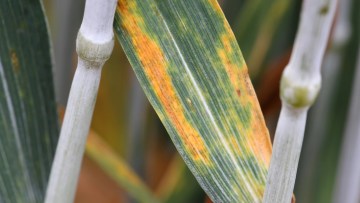Septoria, the number one foliar disease of wheat in the UK
05.02.2021
Dr Jon Helliwell, Business Development Manager

Last season highlighted the consequences of extreme weather and one thing is certain for 2021, flexibility to disease control will be essential to tackle different crop stages, disease pressures, and the variable conditions that mother nature continues to throw at farmers.
In our latest blog, we speak to Dr John Helliwell, Business Development Manager at BASF to look at our number one enemy when it comes to wheat crops – Septoria.
History tells us that Septoria remains the key winter wheat battleground every year. In 2020 it appeared aggressively in crops late-on, and unsurprisingly given the wet start to the year, infection is already evident in some 2021 crops.
Its reputation as the “yield robber” isn’t without substance. The pathogen causes lesions which reduce the photosynthetic capacity of leaves and, in severely affected crops, yield losses of 50% have been recorded.
We know from experience; it is notoriously difficult to control because its populations contain very high levels of genetic variability. The number of mutations, which can change the shape of the target site, within the Septoria population are ever growing, making it more difficult for azole molecules to bind. This results in reduced sensitivity to some conventional azoles in particular, the so-called ‘shifted strains’.

For growers, it becomes even more difficult to manage as it can occur at any time during the growing season. For winter wheat, we often see signs of Septoria infection in early December and whilst it is largely dormant over the winter, it will survive on autumn-sown crops, crop debris and volunteers. As we approach early spring, we tend to see signs of infection on lower leaves of winter-sown crops, especially when we face high winds, generating long distance spread of ascospores.
As we approach spring and summer, the epidemic on the lower leaves spreads up the canopy, often by rain splash or dew. This can be undetectable to the eye for up to 28 days, and this, combined with warm temperature (15 to 20°c) makes this disease incredibly difficult to manage.

So, what does this mean for growers?
- Fungicide choices need to be flexible enough to accommodate any level of Septoria infection both pre- and post-application.
- Drilling date continues to play a key role in determining disease risk.
- Weather events continuously change and predicting future Septoria epidemics with any degree of certainty is very challenging.
- Choosing varieties with strong resistance to Septoria effectively gives another mode of action against Septoria. Combining these genetics with the strongest chemistry is crucial to protect both components
Cultural control measures should be adopted as part of an integrated pest management strategy, but this should be combined with an effective fungicide such as Revystar® XE. With many growers experiencing an extended sowing window, potentially resulting in higher levels of Septoria infection over the winter, it is crucial this season that growers arm themselves with a fungicide that offers the flexibility of a strong curative power with long lasting protection. Revystar® XE will offer this protection.
Revystar® XE and Revysol® are registered trademarks of BASF. Revystar® XE contains Revysol® and Xemium®. Revysol® contains mefentrifluconazole. Xemium® contains fluxapyroxad. Always read the label and product information before use. For further product information including warning phrases and symbols, you can refer to agricentre.basf.co.uk
© BASF 2021 | All rights reserved.
